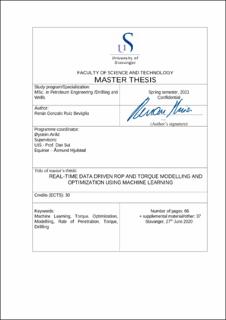| dc.description.abstract | Obtaining the maximum rate of penetration (ROP) is one of many techniques to reduce cost and Non-Productive Time (NPT) in drilling wells. Many parameters affect ROP, including hole cleaning, tooth wear, etc. The study was developed in three parts. First, data was selected, pre-processed and cleaned. In the second part, four machine learning (ML) models (Random Forest (RF), K-Nearest Neighbors (KNN), Gradient Boosting (GB) and AdaBoost (AB) ) were implemented to create a ROP model and a Torque model and the section with the best performance was selected. Finally, two optimization algorithms were tested in selected data. In this case, Particle Swam Optimization (PSO) and Differential Evolution (DE) algorithms were chosen. Once the optimization was performed, a sensitivity analysis was held to check ML methods performance.
In this study, two different parameters (ROP and Torque) were modelled and analysed. Both models use Bit depth, Weight on Bit (WOB), rotary speed (RPM) and pump flow rate (Q) as inputs to make a regression and predict Torque and ROP. In the last part of the study, a new approach is implemented, and modelling is carrying on along with the optimization each 30 meters simulating well drilling with the different optimizers. Hydromechanical Specific Energy (HMSE) was calculated for each 30-meter section and compared with the optimal values in both models. Finally, a sensitivity analysis was performed to evaluate every model and optimizer performance since it was not possible to perform a field experiment. Four ML models were implemented (RF, GB, AB and KNN) among the two algorithms of stochastic optimization and the best combination included GB and DE algorithms after calculating performance metrics and code running time. | |
